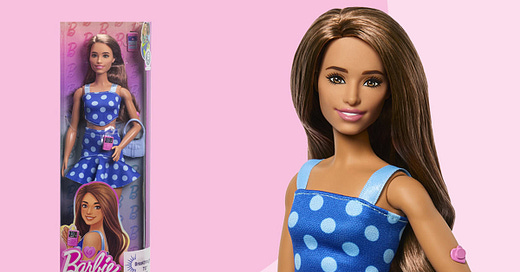Mattel just released a new Barbie with Type 1 diabetes. She wears a CGM on her arm, an insulin pump on her waist, and for a lot of us who’ve lived with this disease, it’s more than just a toy. It’s a small, yet powerful step toward normalizing something that shapes every day of our lives.
The new Barbie is part of the Barbie Fashionistas line, which focuses on inclusion and real-world representation. This version was developed with Breakthrough T1D to make sure the details were accurate: the pump, the sensor placement, and the general vibe are all on point.
Mattel says the goal is to reflect medical conditions like T1D so more kids can see themselves in the dolls they play with, and in the stories they imagine. And it’s already working. Parents are sharing early reviews saying this doll opened the door to conversations about what diabetes is, how it’s managed, and why it shouldn’t be a source of fear or shame.
My Diagnosis Shame
One of the cruelest parts of this disease (for myself and many others) is the age at which you’re commonly diagnosed. I was 11, just turning 12, in my first year of middle school. That age is tough enough as it is with hormones changing, acne, awkward voice squeaks, and all of it happening at different rates from your friends.
The last thing I wanted was to be seen as different. And diabetes made me feel like I stood out like a sore thumb.
I remember screaming at my mom if she mentioned my diagnosis on the phone to one of her friends:
“MOM! What are you doing?! Don’t tell anyone… then they’ll know!”
Now, as an adult and a parent, I understand why a parent would want to share that news. It’s a massive life adjustment for them, too. Every meal and every activity now layered with medical decisions they never had to consider before. But at the time, I couldn’t see that. I just didn’t want anyone to know.
I told only a few close friends. If anyone else asked, I denied it. Looking back, it makes no logical sense, but shame rarely does. No one ever made fun of me. No one used it against me. But I was terrified they would.
It took years to feel comfortable in my own skin. Now, 30 years later, I write and talk about it openly, hoping it helps someone else get there faster.
Why This Doll Matters
Seeing a pump and CGM on a Barbie changes the equation. It tells kids this isn’t something they have to hide.
When a toy this mainstream includes diabetes gear without making it a big deal, it helps take the edge off. It makes the condition part of everyday life instead of something to fear.
And that can mean everything to a kid who’s tired of feeling different.
Tips for Parents Dealing with a Recently Diagnosed Child
If you have a child recently diagnosed, I’m sure you already have your hands full without even dealing with the emotional side of it. But here are a few helpful tips to keep in mind:
Normalize differences. Every kid has something; this is just theirs.
Be honest about your own struggles. Share what made you feel different at that age.
Teach them there’s no shame in managing their health. It’s a skill, and one that can become a superpower they will one day appreciate.
Point them toward role models. Online communities, athletes, creators, and kids who are thriving with T1D.
A Brave New Barbie
This Barbie might not change the world. But she might help a few kids feel less ashamed and less alone. And that’s a huge win we should celebrate together.
Stay strong.





